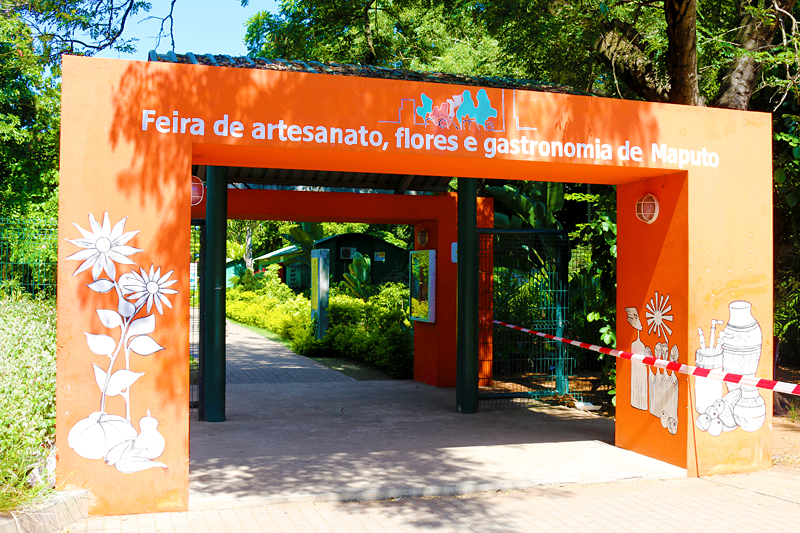I wanted to pick up a small souvenir which was made in Mozambique; so I asked one of the helpful members of the staff at MozGuest Residence — which was where I had stayed overnight in Maputo — and he highly recommended a place not too far away called FEIMA.
“FEIMA?” I asked.
“Yes,” he replied, “that is where the key holder to your room was made.

I noticed how nice the key holder was to my room; and it would have been a nice souvenir in and of itself. I was sold.
“Is FEIMA within walking distance of here?” I asked.
“It would be a long walk,” he replied. “I would take a taxi.”
If I could walk around the northern part of the international airport in Las Vegas, I can easily do this walk.
Although I had a rental car, I did not know whether or not traffic would be as horrendous as it was when I drove into Maputo the day before; nor did I know the parking situation once I arrived. Additionally, the weather of the day was warm and sunny; so I decided to leave the car parked near MozGuest Residence and walk the three kilometers — or roughly 1.86 miles — to Feira de Artesanato, Flôres e Gastronomia de Maputo. The walk was approximately 40 minutes in duration, and — other than Avenida Karl Marx, on which the hotel and other business reside — the walk was mostly through residential neighborhoods, as I passed by local people who were minding their own businesses.
Feira de Artesanato, Flôres e Gastronomia de Maputo — Otherwise Known as FEIMA
There are no signs to direct you to Feira de Artesanato, Flôres e Gastronomia de Maputo — otherwise known as FEIMA — and it does not show up on Google Maps; so getting there can be challenging if you do not have senses of direction or adventure…
…but I was glad to arrive when I saw the square entrance colored orange, as shown in the photograph at the top of this article.

Aside from all of the trees which provide needed shade from the bright sunshine, there are open-air stalls manned by artisans who created the very wares which they sell — each eager to tell you their story but without annoying or irritating you.
When searching for an item, do not immediately decide on what you want to purchase. Every stall had attractive items created by hand by the very artisans who are ready to sell them to you — and one item seemed to be even better than the next. There were large and small items for sale: giraffes made from wood; bowls with beautiful paintings of animals; clothing; batiks; metal trinkets; beaded necklaces; braided bracelets; and all sorts of other items — functional or decorative.
Never accept the marked price. Instead, you are expected to bargain with them; so be prepared to do so. You will most likely save an average of between 15 and 20 percent off of the marked price. There is no need to do any hard bargaining and there is little pressure for you to buy; so the process should not be uncomfortable for you.
Best of all, you support the local economy while bringing home with you an authentic piece of Mozambique — and at a good price.

When the vendors are not busy tending their booths, they can be found hanging around with each other…

…perhaps playing a game of checkers, for example.
After you finish shopping at your own pace — or even if you have not finished shopping yet — there is an area where several vendors offer dining options where you can partake in a quick snack or lunch.

After reviewing menus — such as the one shown in the photograph above for Gastronomia — I decided to order the caril de camarão, which is a shrimp curry and rice dish somewhat similar to a thick shrimp gumbo like you would get in New Orleans; but a different flavor. I was then told to choose any seat at which I want to sit while I wait; and my order will be brought to me.

You can choose from a number of different dishes considered to be traditional cuisine of Mozambique — including matapa, which is a shrimp or crab dish usually prepared with cashew nuts and young cassava leaves and piled with garlic and flour extracted from the tubers; mucapata, which is a rice dish with split peas or beans with coconut milk; and timbawene; which is a type of cowpea or black-eyed pea.

This was the table at which I decided to sit to eat lunch; and my food arrived fewer than 20 minutes later.

The caril de camarão was quite good; and there is more shrimp in the bowl than appears in the photograph shown above. The servers observed me from afar and eventually came by with smiles on their faces to poke fun at me because I was trying the shrimp and curry without mixing in the rice, wanting to taste it; and they told me that I needed to mix the two together, which I did.
Lunch cost me 345 Mozambique new meticals, which is slightly less than seven dollars. The bottle of water was from the hotel at which I stayed.

Aside from the buildings peering off in the distance, one would hardly believe that Feira de Artesanato, Flôres e Gastronomia de Maputo is within the bustling, crowded and noisy capital city of Mozambique.
Summary
It is truly an oasis in the middle of Maputo; and if you ever find yourself in Maputo, I highly recommend that you visit. It was the highlight of my visit.
Feira de Artesanato, Flôres e Gastronomia de Maputo — FEIMA
Avenida dos Martires da Machava
Maputo, Mozambique
Telephone Number: 21 493179
Feira de Artesanato, Flôres e Gastronomia de Maputo is located approximately 50 meters north of Avenida Eduardo Mondlane. Washroom facilities are available near the entrance. Admission is free of charge.
All photographs ©2015 by Brian Cohen.

